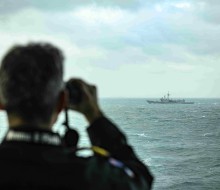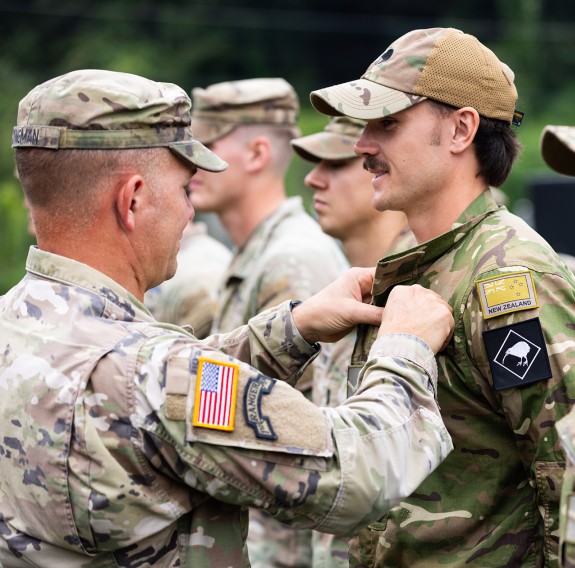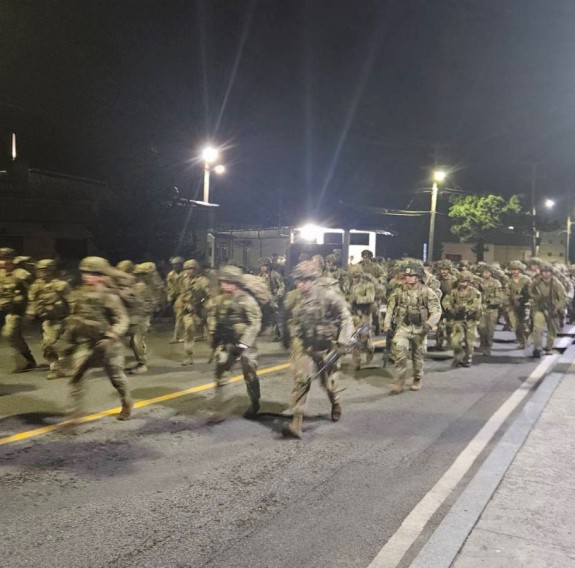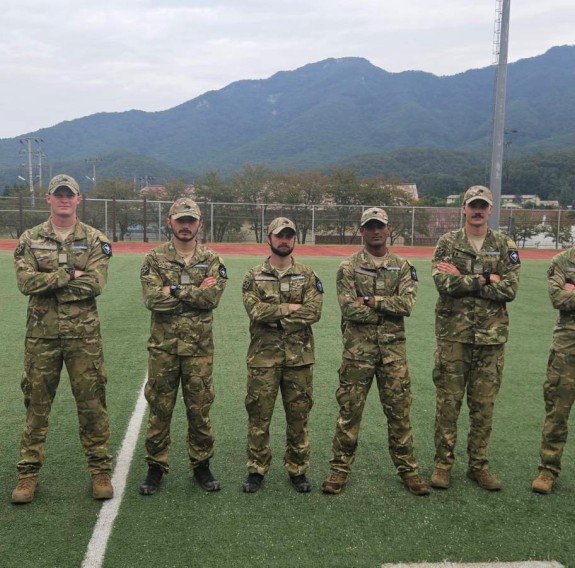
NZDF bolsters North Korea sanctions enforcement with HMNZS Aotearoa and P-8A Poseidon
08 December 2025
Unfortunately you are viewing this website on an outdated browser which does not support the necessary features for us to provide an adequate experience. Please switch to a modern browser such as latest version of Google Chrome, Mozilla Firefox, Apple Safari or Microsoft Edge.
Ngā mihi nui
In a first-time encounter with a gruelling US Army expert-level challenge of fitness and soldiering skills, a team of New Zealand Army soldiers has bettered the typical pass rate.
A New Zealand Army Infantry Platoon, deployed to South Korea earlier this year, was invited to participate in Expert Infantry Badge (EIB) testing alongside United States and Republic of Korean Army personnel at Camp Casey.
The EIB is a special skills badge within the US Army, initiated in 1944 to honour infantryman and symbolise their infantry’s “tough, hard-hitting role in combat”.
To earn it, candidates must pass a demanding sequence of events that validate physical fitness, medical proficiency and tactical fieldcraft.
Across the five-day period, 28 NZ Army soldiers took part, with seven successfully meeting all standards. This 25 percent success rate is notably higher than the average American pass rate of 15 percent.
The five-day challenge began with the Army Combat Fitness Test (ACFT) and land navigation, involving successive days of navigation (day and night), individual skills testing, and culminating in a 12-mile (19.3km) weighted march.
Any failure at any stage meant immediate elimination.

Lance Corporal Will Osborne receives his Expert Infantry Badge, alongside Lance Corporal Matthew Monteiro.

On the move. An early start to the pack march as part of the Expert Infantry Badge challenge

Earning the EIB are Lance Corporal Matthew Monteiro, Lance Corporal Will Osborne, Lance Corporal Cameron Chambers, Lance Corporal Conor Davies, Private Blake McKay, Private Gabriel Milne and Private Taedyn Edmonds-Griffiths.
It was this particular criteria that really put the pressure on, says Private Taedyn Edmonds-Griffiths.
“You’re tested on 30 different infantry skills, and one mistake would mean you were out of the competition.”
Personnel had a week’s preparation, which included having to learn how the US Army performed drills.
“That was probably the hardest part,” says Private Blake McKay.
“You’d think things would be similar, but almost everything was different, including drills with weapons.”
Some weapons were the same or similar to weapons used by the Kiwis but drills were different, which meant resisting muscle memory.
Another tricky task was the navigation exercises, Private McKay said.
“It’s a lot more challenging than people expect. The complex terrain made the land navigation challenging.”
The 12-mile (19km) foot march, which must be completed in three hours or less while carrying 35 pounds (16kg) of weight, was more familiar territory, said Private Edmonds-Griffiths.
“It’s the point of the competition where you are almost finished, it’s just physical and there’s not much thinking involved. Pack marching is normal for us at the end of an exercise.”
Private McKay said it was an awesome opportunity to compare their ability on an international stage.
“For the Americans, it’s an essential thing for their ranking system. They train for up to two weeks, including after-hours study and drills. For us, we looked at it as a challenge.”
Private Edmonds-Griffiths said after hearing what the Americans were saying about it, he didn’t expect to pass.
“But the Americans were really good to us. Heaps of them wanted us to succeed, so they took us under their wing and were really patient. That support really helped.”
The New Zealand platoon has been in South Korea since July and will be coming home this month.
Those who passed the challenge earn a long rectangular blue badge depicting a Springfield Arsenal Musket.
“It would be great if we brought in something similar,” Private McKay said.
“Their awards span across multiple trades – infantry, logistics, combat, even an advanced medic one.”
Lieutenant Steve Ward, who is deployed with the platoon, says their achievement reflects both exceptional individual resilience and the professionalism of the NZ Army’s infantry training.
“It not only underscores interoperability and shared standards between infantry forces, but also sets a strong precedent for future exchange and development opportunities with US Army formations operating in the Indo-Pacific region.”
The NZ Army personnel who qualified for the EIB were: Lance Corporal Matthew Monteiro, Lance Corporal Will Osborne, Lance Corporal Cameron Chambers, Lance Corporal Connor Davies, Private Blake McKay, Private Gabriel Milne and Private Taedyn Edmonds-Griffiths.